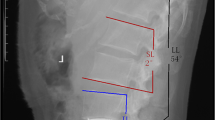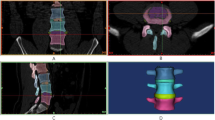Abstract
With regard to the literature, several factors are considered to have an impact on postoperative mobility after lumbar total disc replacement (TDR). As TDR results in a distraction of the ligamentous structures, theoretically the postoperatively disc height and ligamentous integrity have also an influence on biomechanics of a treated segment. The purpose of the study was to evaluate the influence of posterior longitudinal ligament (PLL) resection and segmental distraction on range of motion (ROM). Six human, lumbar spines (L2–L3) were tested with pure moments of ±7.5 Nm in a spine loading apparatus. The ROM was determined in all three motion planes. Testing sequences included: (1) intact state, (2) 10 mm prosthesis (PLL intact), (3) 10 mm prosthesis (PLL resected), (4) 12 mm prosthesis (PLL resected). The prosthesis used was a prototype with a constrained design using the ball-and-socket principle. The implantation of the 10 mm prosthesis already increased the disc height significantly (intact: 9.9 mm; 10 mm prosthesis: 10.6 mm; 12 mm prosthesis: 12.7 mm). Compared to the intact status, the implantation of the 10 mm prosthesis resulted in an increase of ROM for flexion/extension (8.6° vs 10.8°; P = 0.245) and axial rotation (2.9° vs 4.5°; P = 0.028), whereas lateral bending decreased (9.0° vs 7.6°; P = 0.445). The resection of the PLL for the 10 mm prosthesis resulted in an increase of ROM in all motion planes compared to the 10 mm prosthesis with intact PLL (flexion/extension: 11.4°, P = 0.046; axial rotation: 5.1°, P = 0.046; lateral bending: 8.6°, P = 0.028). The subsequent implantation of a 12 mm prosthesis, with resected PLL, resulted in a significant decrease of ROM in all motion planes compared to the 10 mm prosthesis with intact PLL (flexion/extension: 8.4°, P = 0.028; axial rotation: 3.3°, P = 0.028; lateral bending: 5.1°, P = 0.028). Compared to the intact status, the 12 mm prosthesis with resected PLL only decreased lateral bending significantly while the 10 mm prosthesis with intact PLL increased axial rotation significantly. The resection of the PLL during TDR results in a significant increase of ROM in all three principle motion planes. But it still remains unclear if this increase which is in median not more than 1° may alter the clinical results. Moreover, the destabilizing effect of PLL resection can be reversed using a higher implant. The prosthesis height seems more crucial than PLL preservation to maintain the primary stability after TDR.



Similar content being viewed by others
References
Bertagnoli R, Kumar S (2002) Indications for full prosthetic disc arthroplasty: a correlation of clinical outcome against a variety of indications. Eur Spine J 11:131–136
Cakir B, Schmidt R, Huch K, Puhl W, Richter M (2004) Sagittales Alignement und segmentale Beweglichkeit nach endoprothetischer Versorgung lumbaler Bewegungssegmente. Z Orthop Ihre Grenzgeb 142:159–165
Dabbs VM, Dabbs LG (1990) Correlation between disc height narrowing and low-back pain. Spine 15:1366–1369
David T (1993) Lumbar disc prosthesis. Surgical technique, indications and clinical results in 22 patients with a minimum of 12 months follow-up. Eur Spine J 1:254–259
Delamarter RB, Fribourg DM, Kanim LEA, Bae H (2003) ProDisc artificial total lumbar disc replacement: introduction and early results from the united states clinical trial. Spine 28:167–175
Hopf C, Heeckt H, Beske C (2002) Der Bandscheibenersatz mit der SB Charite-Bandscheibenendoprothese - Erfahrungen, Frühergebnisse und Feststellungen nach 35 prospektiv durchgeführten Operationen. Z Orthop Ihre Grenzgeb 140:485–491
Huang RC, Girardi FP, Cammisa FP Jr, Lim MR, Tropiano P, Marnay T (2005) Correlation between range of motion and outcome after lumbar total disc replacement: 8.6-year follow-up. Spine 30:1407–1411
Liu J, Ebraheim NA, Haman SP, Shafiq Q, Karkare N, Biyani A, Goel VK, Woldenberg L (2006) Effect of the increase in the height of lumbar disc space on facet joint articulation area in sagittal plane. Spine 31:E198–E202
Mayer HM, Korge A (2002) Non-fusion technology in degenerative lumbar spinal disorders: facts, questions, challenges. Eur Spine J 11:85–91
Olsewski JM, Schendel MJ, Wallace LJ, Ogilvie JW, Gundra CR (1996) Magnetic resonance imaging and biological changes in injured intervertebral discs under normal and increased mechanical demands. Spine 21:1945–1951
Panjabi M, Henderson G, Abjornson C, Yue J (2007) Multidirectional testing of one- and two-level ProDisc-L versus simulated fusions. Spine 32:1311–1319
Panjabi M, Malcolmson G, Teng E, Tominaga Y, Henderson G, Serhan H (2007) Hybrid testing of lumbar CHARITE discs versus fusions. Spine 32:959–966
Phillips FM, Reuben J, Wetzel FT (2002) Intervertebral disc degeneration adjacent to a lumbar fusion. An experimental rabbit model. J Bone Joint Surg Br 84:289–294
Punt IM, Visser VM, van Rhijn LW, Kurtz SM, Antonis J, Schurink GWH, van Ooij A (2008) Complications and reoperations of the SB Charité lumbar disc prosthesis: experience in 75 patients. Eur Spine J 17:36–43
Shim CS, Lee SH, Shin HD, Kang HS, Choi WC, Jung B, Choi G, Ahn Y, Lee S, Lee HY (2007) CHARITE versus ProDisc: a comparative study of a minimum 3-year follow-up. Spine 32:1012–1018
Shono Y, Kaneda K, Abumi K, McAfee PC, Cunningham BW (1998) Stability of posterior spinal instrumentation and its effects on adjacent motion segments in the lumbosacral spine. Spine 23:1550–1558
Siepe CJ, Korge A, Grochulla F, Mehren C, Mayer HM (2008) Analysis of post-operative pain patterns following total lumbar disc replacement: results from fluoroscopically guided spine infiltrations. Eur Spine J 17:44–56
Szpalski M, Gunzburg R, Mayer M (2002) Spine arthroplasty: a historical review. Eur Spine J 11(Suppl 2):65–84
Weißkopf M, Ohnsorge JAK, Martini F, Niethard FU, Birnbaum K (2008) Influence of inlay height on motion characteristics of lumbar segments in total disc replacement. Z Orthop Unfall 146:452–457
White AA, Panjabi MM (1990) Clinical Biomechanics of the Spine, 2nd edn. J. B. Lippincott Co., Philadelphia
Wilke HJ, Wenger K, Claes L (1998) Testing criteria for spinal implants—recommendations for the standardization of in vitro stability testing of spinal implants. Eur Spine J 7:148–154
Acknowledgments
Approval of the Research Ethics Committee was obtained.
Conflict of interest statement
None of the authors has any potential conflict of interest.
Author information
Authors and Affiliations
Corresponding author
Rights and permissions
About this article
Cite this article
Cakir, B., Richter, M., Schmoelz, W. et al. Resect or not to resect: the role of posterior longitudinal ligament in lumbar total disc replacement. Eur Spine J 21 (Suppl 5), 592–598 (2012). https://doi.org/10.1007/s00586-009-1193-4
Received:
Revised:
Accepted:
Published:
Issue Date:
DOI: https://doi.org/10.1007/s00586-009-1193-4




